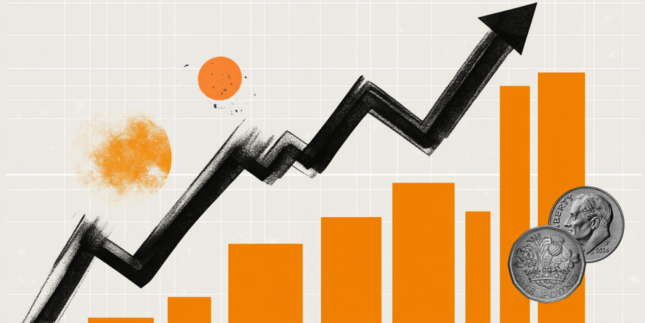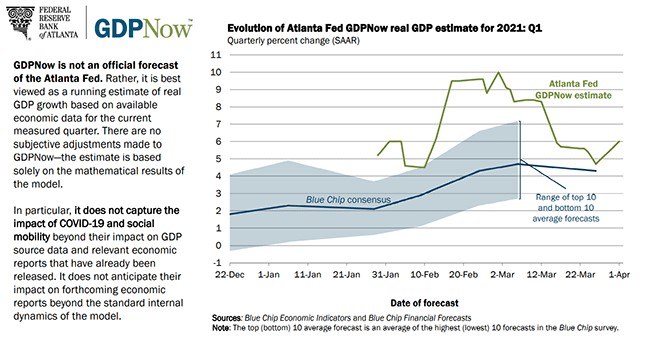- Growth, payrolls, and a waning pandemic signal economic recovery.
- Inflation surfaces in the Producer Price Index, not yet in CPI, PCE.
- Treasury rate increases have steepened the yield curve.
- The Fed has declared current inflation a temporary phenomenon.
- Markets looking for any hint that the Fed is considering curtailing bond purchases.
- Dollar and yields will benefit from any suggestion of a policy change.
Can a fast-growing US economy replace its pandemic labor casualties without triggering a response from the Federal Reserve? Or to put it another way, will accelerating economic growth encourage the governors to pull back on bond purchases, implicitly permitting Treasury and commercial rates to rise?
The American economy has recovered quickly from the December and January lockdown induced swoon with businesses and consumers emboldened by the apparent success of the vaccination campaign.
New payroll hires quadrupled in three months from 233,000 in January to 916,000 in March. At the job creation rate of the first quarter all pandemic losses would be made good by the end of the summer.
Business optimism in manufacturing reached a 38-year high in March. In the dominant service sector managers’ outlook jumped to an all-time record
Services PMI
For consumers, the impact of the March job number on sentiment was evident before the payroll report as the Conference Board and Michigan readings made large and unexpected gains.
Washington’s latest $1400 individual stipend reached most consumers in March. At more than double the December award that produced January's 7.6% burst in Retail Sales, this grant is expected to produce a second, smaller, 4.4% jolt in consumption.
American equities are setting new highs every other day it seems. The dollar has executed a New Year’s reversal against all majors except the Canadian dollar whose resource-based and US-tied economy will partake of the US good fortune.
So far, the swift first quarter recovery has been all the Fed could hope for and, according to most estimates including its own, the expansion will continue through the rest of the year.
Inflation, however, remains an uncertainty as does the correct policy response.
Inflation and the Fed
Thus far price gains have been limited to the Producer Price Index (PPI) which rose 0.5% on the month and 2.8% on the year in February. The annual rate is expected to jump to 3.8% in March when it is released on April 9.
PPI
The Consumer Price Index (CPI) increased 0.4% (MoM) and 1.7% (YoY) in February, rates that are predicted to be unchanged when the March figures are issued on April 13.
Finally, the Personal Consumption Expenditure Price Index (PCE), the Fed’s elected measure, was 0.2% monthly and 1.6% annually in February after 0.3% and 1.4% in January. The Match data will be released April 30.
Federal Reserve Chairman Jerome Powell has said that the bank expects any price increases to be temporary and largely due to the base effect of the sharp pandemic declines last spring..
It is correct that all three price gauges had steep declines in the first three months of the pandemic last year. For Instance the PCE Price Index dropped from 1.8% in February to 1.3% in March, and 0.5% in April and May. The return of prices to normal inflation rates this year will produce an exaggerated percentage gain in the 2021 comparison. That effect diminishes as the rates normalize.
But the base effect is not the sole inflation concern, though it is the only one documented so far.
Several other factors make a more systemic increase in inflation plausible, if not certain.
First is the enormous amount of money that Washington has and is planning to pump into the economy. The last two stimulus bills totaled over $3 trillion and the Biden administration is asking Congress to match that within the next few months.
Second, demand will likely surge as people return to work and shake off the restraints of the past year. The pandemic relief will almost assuredly find expression in consumer spending.
Lastly, the pandemic has left bottlenecks, backlogs and limited supply for many consumer items. It is unknown whether shortages in the coming months will prompt enough price increases to affect the inflation rate but it is a possibility.
Countering the Fed's previous, more immediate approach to price increases is the recent adoption of inflation averaging. This policy permits the FOMC to let price gains run ahead of the 2% goal for as long as needed to bring the average rate to that target. In effect, this delayed response removes the credit markets speculative rate trigger.
Conclusion: Interest rates and economic growth
The Fed has made it clear that it no longer follows a reactive inflation policy and that price changes are not at the center of its considerations.
Economic growth and employment are the bank’s focus and the rationale for keeping short-term rates near their historical lows.
Even though the fed funds rate is unchanged by the Fed’s own estimates through the end of 2023, that does not mean the $120 billion each month in bond purchases has the same expected longevity.
Markets anticipate that as US economic growth accelerates the Fed will reduce and eventually end its bond program. That expectation is one of the chief reasons behind the steepening of the Treasury yield curve this year.
The FOMC minutes will be scoured for clues to the logic, timing, and size of any change to the Treasury intervention.
Any discussion of the conditions neeeded for a reduction in bond purchases will be taken as indication that the time is approaching. Treasury yields and the dollar will act accordingly.
Information on these pages contains forward-looking statements that involve risks and uncertainties. Markets and instruments profiled on this page are for informational purposes only and should not in any way come across as a recommendation to buy or sell in these assets. You should do your own thorough research before making any investment decisions. FXStreet does not in any way guarantee that this information is free from mistakes, errors, or material misstatements. It also does not guarantee that this information is of a timely nature. Investing in Open Markets involves a great deal of risk, including the loss of all or a portion of your investment, as well as emotional distress. All risks, losses and costs associated with investing, including total loss of principal, are your responsibility. The views and opinions expressed in this article are those of the authors and do not necessarily reflect the official policy or position of FXStreet nor its advertisers. The author will not be held responsible for information that is found at the end of links posted on this page.
If not otherwise explicitly mentioned in the body of the article, at the time of writing, the author has no position in any stock mentioned in this article and no business relationship with any company mentioned. The author has not received compensation for writing this article, other than from FXStreet.
FXStreet and the author do not provide personalized recommendations. The author makes no representations as to the accuracy, completeness, or suitability of this information. FXStreet and the author will not be liable for any errors, omissions or any losses, injuries or damages arising from this information and its display or use. Errors and omissions excepted.
The author and FXStreet are not registered investment advisors and nothing in this article is intended to be investment advice.
Recommended Content
Editors’ Picks

AUD/USD: Strong resistance lies at 0.6300
The marked sell-off in the US Dollar allowed AUD/USD to regain strong upside traction and reach multi-day highs in the area just below the key 0.6300 barrier at the beginning of the week.

EUR/USD: Bulls need to clear 1.0400 on a convincing fashion
In line with the rest of the risk-associated complex, EUR/USD managed to regain marked buying pressure and flirted with the area of three-week highs around 1.0430 on Monday.

Gold remains focused on all-time highs
Gold stays in positive territory above $2,700 on Monday as the improving risk mood makes it difficult for the US Dollar to find demand. Markets await US President Donald Trump's speech at the inauguration ceremony.

Solana Price Forecast: Are US traders dumping Bitcoin and XRP for SOL?
Solana (SOL) price stabilized near the $250 support level on Monday, having declined 10% from its all-time high over the last 24 hours.

GBP/USD stays defensive below 1.2200, awaits Trump 2.0
GBP/USD struggles to gain traction and trades slightly below 1.2200 in the second half of the day on Monday. Markets' nervousness ahead of US President-elect Donald Trump's inauguration drag the pair lower despite a broadly weaker US Dollar.

Trusted Broker Reviews for Smarter Trading
VERIFIED Discover in-depth reviews of reliable brokers. Compare features like spreads, leverage, and platforms. Find the perfect fit for your trading style, from CFDs to Forex pairs like EUR/USD and Gold.


